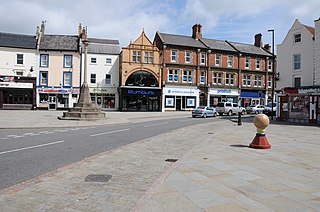
Grantham is a market town in the South Kesteven district of Lincolnshire, England, situated on the banks of the River Witham and bounded to the west by the A1 road. It lies some 23 miles (37 km) south of Lincoln and 22 miles (35 km) east of Nottingham. The population in 2016 was put at 44,580. The town is the largest settlement and the administrative centre of South Kesteven District.
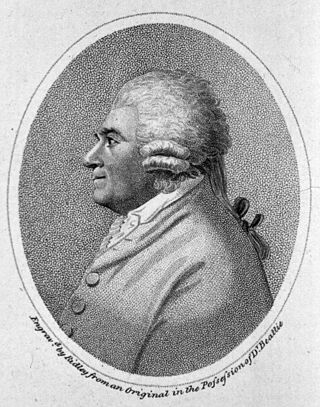
James Beattie was a Scottish poet, moralist, and philosopher.

Christopher Hatton, 1st Baron Hatton KB PC FRS was first cousin twice removed to the Elizabethan politician, Sir Christopher Hatton and a prominent Royalist during the reign of King Charles I of England.
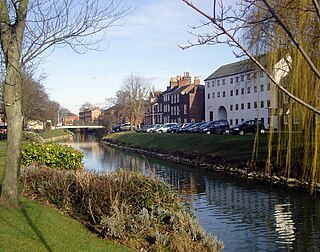
Spalding is a market town on the River Welland in the South Holland district of Lincolnshire, England. The town had a population of 34,113 at the 2017 census. The town is the administrative centre of the South Holland District. The town is located between the cities of Peterborough and Lincoln, as well as the towns of Bourne, Market Deeping, March, Boston, Wisbech, Holbeach and Sleaford.

Sir Frank Merry StentonFBA was an English historian of Anglo-Saxon England, a professor of history at the University of Reading (1926–1946), president of the Royal Historical Society (1937–1945), Reading University's vice-chancellor (1946–1950).

The Selden Society is a learned society and registered charity concerned with the study of English legal history. It functions primarily as a text publication society, but also undertakes other activities to promote scholarship within its sphere of interest. It is the only learned society wholly devoted to the topic of English legal history.
The Ray Society is a scientific text publication society that publishes works devoted principally to British flora and fauna. As of 2019, it had published 181 volumes. Its publications are predominantly academic works of interest to naturalists, zoologists, botanists and collectors.
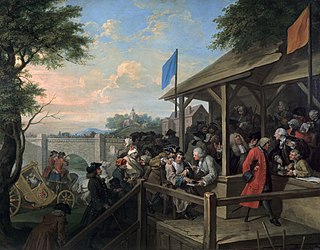
Oxfordshire was a county constituency of the House of Commons of the Parliament of England then of the Parliament of Great Britain from 1707 to 1800 and of the Parliament of the United Kingdom from 1801 to 1885. It was represented by two Members of Parliament. In 1832 this was increased to three Members of Parliament. The constituency was abolished in 1885, being split into three single member divisions.
Stamford was a constituency in the county of Lincolnshire of the House of Commons for the Parliament of England to 1706 then of the Parliament of Great Britain from 1707 to 1800 and of the Parliament of the United Kingdom from 1801 to 1918. It was represented by two Members of Parliament until 1868 when this was reduced to one.

A text publication society is a learned society which publishes scholarly editions of old works of historical or literary interest, or archival documents. In addition to full texts, a text publication society may publish translations, calendars and indexes.
The Spalding Gentlemen's Society is a learned society based in Spalding, Lincolnshire, England, concerned with cultural, scientific and antiquarian subjects. It is Britain's oldest such provincial body, founded in 1710 by Maurice Johnson (1688–1755) of Ayscoughfee Hall. Membership is open to anyone aged 18 or over: the term "gentlemen" in the title is historical – there is no discrimination between men and women. Its Grade II listed museum in Broad Street, Spalding, was designed by Joseph Boothroyd Corby and opened in 1911; additions to the building ensued in 1925 and 1960. The carved outside panels were by Jules Tuerlinckx of Malines, a Belgian refugee in the First World War.
The text of Domesday Book, the record of the great survey of England completed in 1086 executed for William I of England, was first edited by Abraham Farley in the 1770s. The first facsimile edition of the manuscripts was made in a project led by the cartographer Henry James in the 1860s. An English translation of the Latin text for most counties was published by the Victoria County History (VCH) during much of the 20th century.
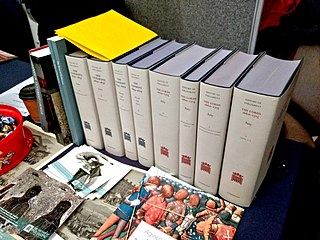
The History of Parliament is a project to write a complete history of the United Kingdom Parliament and its predecessors, the Parliament of Great Britain and the Parliament of England. The history will principally consist of a prosopography, in which the history of an institution is told through the individual biographies of its members. After various amateur efforts the project was formally launched in 1940 and since 1951 has been funded by the Treasury. As of 2019, the volumes covering the House of Commons for the periods 1386–1421, 1509–1629, and 1660–1832 have been completed and published ; and the first five volumes covering the House of Lords from 1660 to 1715 have been published, with further work on the Commons and the Lords ongoing. In 2011 the completed sections were republished on the internet.
Doris Mary Stenton, Lady Stenton, (1894–1971) was an English historian of the Middle Ages.
John Stuart LLD (1813–1877) was a Scottish genealogist.
The London Record Society is a text publication society founded in 1964 whose objectives are to stimulate public interest in archives and similar historical material relating to London. The President of the society is the Lord Mayor of London. The Society is a registered charity.
Henry Kaye Bonney D.D. was an English churchman, photographer and author.
Surrey Record Society is a text publication society which edits and publishes historic records relating to the county of Surrey, England. The society concerns itself with the historic county, which includes, in addition to the current administrative county, the areas now forming the London boroughs of Lambeth, Wandsworth, Southwark, Croydon, Kingston, Merton, Sutton, and Richmond. The Society has also published two editions of registers of medieval bishops of Winchester, Surrey having historically formed part of the Diocese of Winchester.
The Canterbury and York Society is a British text publication society founded in 1904. It publishes scholarly editions of English medieval (pre-Reformation) ecclesiastical records, notably episcopal registers.
Canon Charles Wilmer Foster, FSA, FRHistS (1866–1935) was an English clergyman, antiquarian, historian and archivist. He founded the Lincoln Record Society in 1910 and served as its secretary and general editor until his death; he made major contributions towards scholarship on the county and diocese of Lincoln, principally through publishing editions of historical documents.








